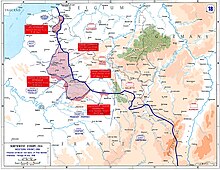Zone rouge
As Zone rouge (German " Red Zone ") are in France indicates the areas in which the main combat zones of up World War I were. This is where the great material and wear and tear battles took place. Some of these areas were completely devastated and after the war the landscape resembled a lunar landscape with shell holes and trenches criss-crossed. Even today, entering these areas is sometimes dangerous, as there are still a lot of ammunition and poison gas remains in the ground.
The Western Front in World War I

After the outbreak of war, German military planning in accordance with the Schlieffen Plan concentrated on the rapid overthrow of France, which however failed. After initial success, the German attack got stuck about 50 km from Paris and froze to trench warfare. The armies of millions of the warring states (on the western front essentially the German Reich and on the side of the Allies France , the British Empire , Belgium and, since 1917, the United States ) faced each other in heavily fortified positions. Both sides tried to break through the enemy's lines by means of massive use of artillery and new types of weapons such as poison gas or tanks , which were supposed to have a surprise effect. Ultimately, however, these attempts were largely unsuccessful. In the great battles of Champagne (1915), Verdun (1916), the Somme (1916), Cambrai and Arras (1917), hundreds of thousands of soldiers were killed on both sides, but the front line only moved a few Kilometers, only to freeze again in trench warfare. The only exceptions were the great German spring offensive in the last year of the war in 1918, which broke through the front broadly, but soon collapsed due to the Allied resistance and the total exhaustion of the German army, as well as the Allied Hundred Days Offensive that followed. A few months after this turning point, the war was over and the German armies evacuated the occupied territories after the armistice of Compiègne .
War damage


The war on the Western Front took place mainly on French and Belgian soil. For only a few weeks in the first year of the war during the French offensive in southern Alsace and Lorraine, there were acts of war on German soil. The French troops were pushed back, however, and only a small part of southern Alsace remained under French control until the end of the war. The war damage in France was enormous. Entire landscapes were downright plowed up by the grueling trench warfare and artillery fire and numerous villages razed to the ground. Many cities were badly hit by artillery fire or air raids. The infrastructure (roads, bridges, railways) of entire regions was destroyed. The French Ministry for the Liberated Areas (Ministère des Régions libérées) divided the areas into three zones according to the degree of their destruction: Zones vertes (green zones) with only moderate damage, Zones jaunes (yellow zones) with more severe damage and Zones rouges (red zones), which corresponded to the actual main combat areas. The first measures to repair the war damage included the removal of ammunition remains, which was often done by German prisoners of war, as well as the recovery of human remains, which then in large necropolises and cemeteries such. B. were buried in the Douaumont ossuary near Verdun. Many destroyed villages were not rebuilt. In many cases, devastated areas have been reforested. In the arrondissement of Châlons-en-Champagne , a large area near Suippes was rededicated as the Mourmelon military training area. Contamination by poison gas grenades and ammunition residues with heavy metals represented a particular problem, so that renewed agricultural use often had to be avoided.
The French public expected that Germany should pay for the damage caused ( L'Allemagne paiera - Germany will pay!). The French politicians were under considerable pressure from an angry and nationalistically incited public who expected tough and unrelenting action, especially on the reparations question against Germany. On the other hand, the severe war damage in France was hardly noticed by the German public, because here too the civilian population suffered during the war (in the " turnip winter " of 1916/17 alone there were hundreds of thousands of additional deaths, ultimately due to the catastrophic supply situation), felt himself a victim of war and was preoccupied with the economic problems of the post-war period ( hyperinflation of 1923 ). People who publicly pointed out the damage the war had left on French soil, such as: B. Albert Einstein, after visiting the former battlefields in 1922 on the occasion of his visit to Paris , found himself exposed to nationalist attacks.
Todays situation
Immediately after the war, the area of the Zones rouges was 178,511 hectares . Little by little, more and more areas were made available for human use. In 1927, the rouges zones comprised 48,820 hectares. Large parts of the rouges zones were reforested (Forêt de guerre) , which significantly increased the forest area, for example in Champagne . Even today there are numerous remains of what happened back then on the former battlefields, which is also used in part by militaria collectors who illegally search for objects with metal detectors . The soil is still considered to be due to remnants of ordnance, e.g. B. Heavy metals, chemically contaminated.
Web links
- The Battle of Verdun - a look ( Memento from March 13, 2012 in the Internet Archive )
- The Forbidden Forest - Where the Great War continues to generate casualties
- Kathryn Hadley: Lost Villages of Champagne, in History Today 58 (11) 2008
- Reconstruction (post-war reconstruction using the example of Artois )



